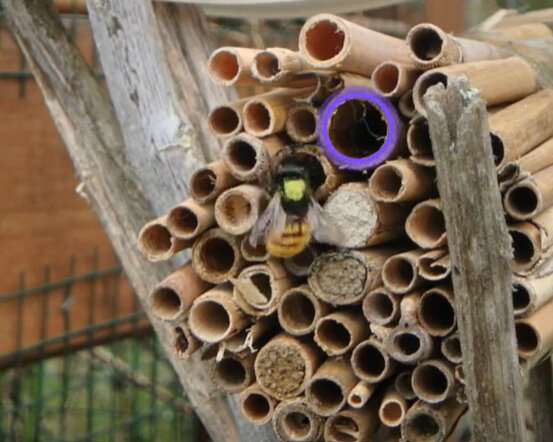This article has been reviewed according to Science X's editorial process and policies. Editors have highlighted the following attributes while ensuring the content's credibility:
fact-checked
peer-reviewed publication
trusted source
proofread
Biologists investigate how bees identify their own nests

Not all bees and wasps live in colonies of several thousand individuals. The horned mason bee (Osmia cornuta), for example, nests solitarily. When choosing a nesting site, the females often use existing cavities ranging from abandoned nests of other bee species to wall cracks and artificial nesting aids such as insect hotels.
Dr. Sylvie Vandenabeele has determined how the bees distinguish their brood cavities from those of their conspecifics as nests are often in close proximity to each other. The biologist now works at the Chair of Zoology II at the Julius-Maximilians-Universität Würzburg (JMU). For the study, she worked with Professor Thomas Schmitt of the Chair of Zoology III. Their work has now been published in the journal Proceedings of the National Academy of Sciences.
Olfactory markers point the way
"Previous studies had suggested that bees use vision to return to their nests. Our hypothesis was that olfactory markers also play an important role," says Vandenabeele. Chemical analyses and behavioral experiments showed that bees do use olfactory cues present at their nest entrances. These have the same olfactory profile as the insects bear on their cuticle, the outermost shell.
The importance of the nest olfactory cues became apparent when the researchers removed them. "The bees appeared disoriented, barely able to locate their own nest," explains Vandenabeele.
Better understanding for better protection
The study confirms that the horned mason bee uses multiple senses for orientation, a strategy that is likely to be transferable to different insect species.
Considering the massive decline of pollinators and the resulting impact on our ecosystems, a better understanding of these insects is of the utmost importance. On the one hand, protection and support measures could be optimized. On the other hand, the results of the study open up further possibilities for research in the areas of sensory perception of insects and communication between them.
Vandenabeele sees possible next steps for her research in extending the experiments to additional species of solitary nesting Hymenoptera. "For example, there is the question of whether nesting strategies have an influence on the importance of the olfactory component, or even whether predators can also use the scents to locate nests," she says.
More information: Sylvie P. Vandenabeele et al, Olfaction is essential for nest recognition in solitary Hymenoptera, Proceedings of the National Academy of Sciences (2023). DOI: 10.1073/pnas.2304703120
Journal information: Proceedings of the National Academy of Sciences
Provided by Julius-Maximilians-Universität Würzburg




















